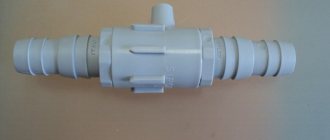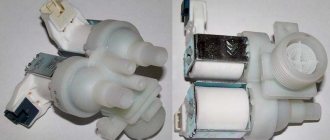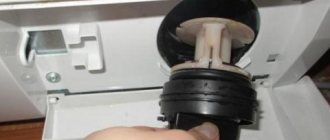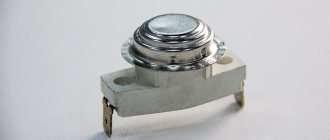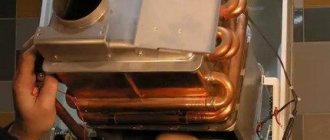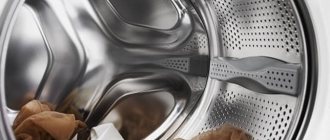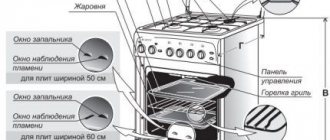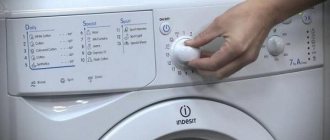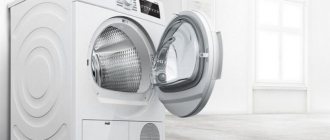Currently, a washing machine is an integral attribute in every apartment. Any housewife is interested in keeping her linens crystal clean. The quality of washing depends not only on the characteristics of the machine and powder, but also on the correct connection. The washing machine must not only pump clean water, but also ensure that waste water is discharged into the sewer system. As a rule, there are no problems with water injection. And illiterate organization of drainage can lead to a number of problems. Dirty water from sewer pipes can flow back into your car. To block the reverse flow of water, it is necessary to install a check valve on the drain hose of the washing machine, which is also called an anti-siphon.
Non-return valve for washing machine drain
Currently, a washing machine is an integral attribute in every apartment. Any housewife is interested in keeping her linens crystal clean. The quality of washing depends not only on the characteristics of the machine and powder, but also on the correct connection. The washing machine must not only pump clean water, but also ensure that waste water is discharged into the sewer system. As a rule, there are no problems with water injection. And illiterate organization of drainage can lead to a number of problems. Dirty water from sewer pipes can flow back into your car. To block the reverse flow of water, it is necessary to install a check valve on the drain hose of the washing machine, which is also called an anti-siphon.
Why do you need an antisiphon?
High-quality washing is impossible without an anti-siphon. Its main function is to pass dirty water into the sewer and prevent it from entering back. An anti-siphon is a small pipeline element with a tip for connecting to a hose and a built-in check valve. The diameters of the inlet and outlet pipes are different. Most often, this device is sold complete with a washing machine.
Anti-siphon valve
Without it, high-quality washing is only possible if certain operating conditions are met. The main condition is that the drain hose must be higher than the sewer pipes. Many people organize a drain right next to the floor in order to preserve the interior. This erroneous decision leads to an increase in the siphon effect. But even with a properly connected machine, problems can arise. If the sewer pipes have not been changed for a long time, a “siphon effect” also occurs when draining.
This is quite easy to determine. The operating time increases significantly, the quality of washing decreases, and energy costs increase. These are manifestations of the “siphon effect”. It appears if the drainage is not organized correctly. The diameter of the machine drain hose is much smaller than the diameter of the sewer pipe. Draining leads to a release of pressure, water is pumped out of the drum. The machine is forced to draw water from the water pipe and heat it. As a result, the operating time of the unit increases and water consumption increases. These problems can be avoided by installing a siphon with a check valve.
Operating principle of a check valve
A siphon with a check valve is mounted on the drain pipeline in an arbitrary location. When the drain program is turned on, the pump starts to pump out water. The pressure in the hose increases and water flows freely through the valve. After the drain cycle completes, the water stops flowing and the pressure drops. In this case, the device closes, blocking the passage. A tight connection is formed. In this way, the passage for water to enter the drum from the pipe is blocked. Due to the height difference between the inlet and outlet pipes, the reaction time to pressure changes is minimal.
This is interesting: How to change pipes in a bathroom with your own hands
The most commonly used locking device is:
- polypropylene ball;
- spring.
The principle of operation of the antisiphon
The locking mechanism is a small ball of air. When direct fluid pressure is removed, the ball rests against the sealing membrane. When back pressure occurs, the force of pressing the ball against the membrane only increases. Reverse penetration of liquid is not possible.
No ball cleaning required. Special ribs in the valve body serve for self-cleaning of the ball. A siphon with a spring valve uses a spring as the closing mechanism.
The design of the mechanism makes it possible to install it on any section of the pipeline. The installation location does not affect the quality of work.
All valve modifications are made of high-quality durable plastic. Therefore, the devices have a long service life. The service life can only be affected by water quality. Too hard water in the water supply system destroys the elements of the device.
Types of check valves
There are several types of antisiphons for washing machines:
- collapsible (segmental);
- non-separable;
- wall;
- mortise;
- washing
Types of antisiphons
Double check valve
Wall check valve
It is better to choose collapsible devices for houses with hard water. If it gets dirty, it can be dismantled and disassembled. Without cleaning, the device can quickly fail. In addition, only such valves are suitable for certain brands of washing machines (for example, from the manufacturer LG). This is usually stated in the instructions for the washing machine. If the water is of good quality, a non-separable option is quite suitable. It is much cheaper than segment ones.
Non-separable valves are subject to forced replacement. Devices need to be checked and replaced more often with hard water.
Mortise devices are convenient to use when connecting a direct drain into a sewer pipe. To install the valve, a special mortise hole is prepared in the pipe. This connection option is somewhat more complicated.
Wall-mounted ones have the most aesthetic appearance. But they are significantly more expensive than others. It is mounted between the washing machine and the wall. This is the most compact device.
Wall check valve
The washer is not suitable for washing machines. Their purpose is a sink siphon. There are also many models with decorative inserts. Inserts are usually made of high quality stainless steel. But such models are several times more expensive. But it should be remembered that appearance does not affect quality.
There are no special rules when choosing an antisiphon. The main thing is that the device fits the washing machine and the drainage structure. Therefore, first of all, you need to carefully study the machine’s instructions and the design features of the sewer pipes.
DIY installation
Installing the device is not particularly difficult. The installation principle for all varieties is approximately the same:
- connect the siphon to the valve tube (for mortise ones - install it in a pre-prepared cutout in the pipe);
- connect the second output to the drain hose of the washing machine;
- seal all joints with sealant.
Antisiphon tubes have different diameters. Therefore, incorrect connection is completely excluded. The most important thing is to ensure the tightness of all connections.
It must be remembered that in drain mode there is strong vibration of the hose. High-quality connections will help avoid leaks. Before starting, it is necessary to check the operation of the sewer system. If water flow is poor, the pipes need to be cleaned.
This is interesting: How to make an outdoor washbasin yourself
Which manufacturers are better
Check valves for washing machines can be purchased at any hardware store. The variety of manufacturers and price range is quite wide. To ensure that the device works for a long time, when purchasing, it is better to give preference to trusted suppliers. The table shows the most common devices from well-known brands.
| Manufacturer | Type | Characteristics |
| Alcaplast, Czech Republic | APS2 | Plastic, ? 32 mm, for any hoses, one-piece |
| Siroflex, Italy | 012677 | Mortise, spring. |
| Merloni, Italy | 95101800 | Mortise, plastic |
| McALPINE, Scotland | WMV-32WH | Plastic, ? 19-25×32, one-piece |
| ANI Plast | P-12/M500/APS2 | Minisiphon (wall-mounted) |
Whether or not to install a siphon with a check valve is up to everyone to decide for themselves. But you should remember that without it it is impossible to organize a drain. The quality of washing decreases, washing time, water and electricity consumption increases. An inexpensive device that is easy to install even without the involvement of specialists will help avoid these problems.
Why do you need an antisiphon?
High-quality washing is impossible without an anti-siphon. Its main function is to pass dirty water into the sewer and prevent it from entering back. An anti-siphon is a small pipeline element with a tip for connecting to a hose and a built-in check valve. The diameters of the inlet and outlet pipes are different. Most often, this device is sold complete with a washing machine.
Anti-siphon valve
Without it, high-quality washing is only possible if certain operating conditions are met. The main condition is that the drain hose must be higher than the sewer pipes. Many people organize a drain right next to the floor in order to preserve the interior. This erroneous decision leads to an increase in the siphon effect. But even with a properly connected machine, problems can arise. If the sewer pipes have not been changed for a long time, a “siphon effect” also occurs when draining.
This is quite easy to determine. The operating time increases significantly, the quality of washing decreases, and energy costs increase. These are manifestations of the “siphon effect”. It appears if the drainage is not organized correctly. The diameter of the machine drain hose is much smaller than the diameter of the sewer pipe. Draining leads to a release of pressure, water is pumped out of the drum. The machine is forced to draw water from the water pipe and heat it. As a result, the operating time of the unit increases and water consumption increases. These problems can be avoided by installing a siphon with a check valve.
Necessity of application
If the drain hose is connected to the sewer outlet in violation of plumbing standards, then it is likely that dirty water from the sewer pipe will return to the drum of the washing machine. As a result, at the end of the wash you will end up with stale, foul-smelling laundry. The check valve is designed to prevent such a development of events (which, by the way, is called the “siphon effect”).
A non-return valve or anti-siphon should be installed when it is not possible to install the drain hose at the required height. Another case in which this device cannot be avoided is when the washing machine drain is connected through the sink siphon.
You should also think about installing an anti-siphon if you notice signs of a siphon effect during washing. These include: increased washing time, poorly washed items, increased consumption of water and electricity by the washing machine.
Which manufacturers are better
Check valves for washing machines can be purchased at any hardware store. The variety of manufacturers and price range is quite wide. To ensure that the device works for a long time, when purchasing, it is better to give preference to trusted suppliers. The table shows the most common devices from well-known brands.
| Manufacturer | Type | Characteristics |
| Alcaplast, Czech Republic | APS2 | Plastic, ? 32 mm, for any hoses, one-piece |
| Siroflex, Italy | 012677 | Mortise, spring. |
| Merloni, Italy | 95101800 | Mortise, plastic |
| McALPINE, Scotland | WMV-32WH | Plastic, ? 19-25×32, one-piece |
| ANI Plast | P-12/M500/APS2 | Minisiphon (wall-mounted) |
Whether or not to install a siphon with a check valve is up to everyone to decide for themselves. But you should remember that without it it is impossible to organize a drain. The quality of washing decreases, washing time, water and electricity consumption increases. An inexpensive device that is easy to install even without the involvement of specialists will help avoid these problems.
How does it work?
A check valve is a fairly simple device made of stainless metal or plastic. In appearance, it is a bit like a shut-off valve, and its operating principle is similar. An anti-siphon is needed to regulate the flow of water in the pipe, allowing it to move only in one direction.
Initially, the check valve is in a locked state, but when the drain mode is activated, it opens under the pressure of water. When the drain program is turned off, the valve automatically closes, preventing water from returning.
Types of valves
There are quite a few types of antisiphon. Before purchasing, explore the available options and choose yours. There are five options for such valves on the market:
- solid;
- segmented;
- wall;
- requiring cutting;
- installed under the sink.
There are no significant differences between them; all devices are designed for the same purpose - to protect the machine from the return of dirty water and to ensure the normal drainage of waste liquid. However, connecting specific washing machines to the drain has its own characteristics.
If the water in your water supply is far from perfect, it is best to purchase a segmented anti-siphon. This will ensure the possibility of subsequent disassembly and cleaning of the system from water debris and various deposits.
Important! Even if the quality of the water from the pipeline is good, it is necessary to change the valve every few years. The procedure is simple, you can do it yourself.
Anti-siphon wall
Wall antisiphons are expensive. Their use is justified when the drain is located in a small space between the walls and the outer panel of the washing machine. This type of valve is very compact and will significantly save space when located along the wall. Among other things, this type of anti-siphon looks quite stylish and can become part of the interior.
Flush-type valves are ideal for drains that pass directly through a sewer pipe. In this case, the drain is equipped with a tie-in, and a check valve is installed on it. The anti-siphon, which is installed under the sink, is usually combined with the sink siphon. It is suitable for almost every siphon model, does not take up much space, is practical and easy to use.
Kinds
There are several types of check valves on the modern plumbing equipment market. They differ in design features, type of installation and scope of application.
Main types of antisiphons:
- collapsible - a metal device consisting of several parts; this type is convenient because, if necessary, it can be disassembled and cleaned;
- non-removable - monolithic structure made of plastic; considered the most budget option;
- mortise - a valve that is installed directly into the pipe, in place of a piece cut out of it;
- washing – check valve intended for use in drain siphons of sinks and washbasins;
- wall-mounted – a beautiful structure made of chromed metal that is mounted on the wall; the most expensive option of all of the above.
This is interesting: The kitchen sink is clogged, what to do: folk and mechanical methods, how to clean it
Varieties
- Collapsible (segmental);
It is better to choose collapsible elements for houses with high water hardness. In case of blockage, it is dismantled and disassembled; without proper care (cleaning), the device quickly fails. Manufacturers of some brands of washing machines recommend this type of valve.
- Non-separable;
A non-separable element in the event of malfunctions is subject to forced replacement. Frequent checking and replacement of the device is necessary if the water hardness is high.
- Wall mounted;
It is installed in free space, which is located next to the washing machine and the wall. They have a compact and aesthetic appearance, but this makes a significant difference in price.
- Mortise;
When using direct drainage, mortise devices are used during connection to the sewer pipe. To do this, a special hole is cut into the pipe, which is more difficult to perform.
- Washing.
The washing option is not suitable for washing machines; they are used for sinks.
Features of use
- Some manufacturers of household appliances add a check valve to the basic configuration of washing machines, but not all do this. Therefore, most likely, you will have to purchase this device yourself in a specialized store.
- If you connect the drain using a check valve, then you do not have to worry about following the recommendations regarding the height of the drain hose. The main thing is to install all elements of the system in such a way that they can be easily accessed in case cleaning or repairs are needed.
- When purchasing a check valve, be prepared for the fact that this device will have to be replaced every few years, as it will be exposed to hard tap water. The better the quality of the product, the longer it will last, but you still shouldn’t overpay - no matter how expensive the device is, sooner or later it will need to be replaced.
Operating principle
The check valve for connecting a washing machine to the sewer is no different from all devices of this type. The principle of its operation is based on cutting off the movement of water in one direction and its free passage in the other. The working body of the valve is a ball or a special slide that can move to one side to allow flow to pass. Under the pressure of a stream of water, they open the passage, but when exposed from the opposite side, the cross-section of the tube is blocked.
It is recommended to install a sewer check valve for the washing machine from the first days of operation. Effluent remains in the hose, especially if an extension is used. When filling the machine with water, dirt gets into the drum, which impairs the quality of the wash. In addition, the danger of self-draining or other undesirable effects does not appear over time, it is always there. Even a new machine, just purchased and turned on for the first time, is at risk if the drain hose is incorrectly positioned.
Please note that the valve has a limited service life. The moving parts of the structure are gradually covered with a layer of lime deposits. The tightness decreases, the ability to open to the desired position decreases. If you do not pay attention to the condition of the device, after a while it will simply stop functioning. Therefore, it is necessary to change the valve in a timely manner so as not to end up in an unpleasant situation. The machine will complete the entire wash cycle and begin draining waste water, but the valve will not open. The pump will run continuously until it burns out. If at this moment no one is at home in order to detect the problem in time and at least stop the process, the car will have to be repaired.
Varieties and manufacturers
It is necessary to select the right sewer valve for the washing machine, since the mechanics of drainage from different manufacturers have their own specifics. In addition, some companies install an internal valve on their products, eliminating the possibility of dangerous effects. When purchasing a machine, before starting it for the first time, you need to clarify this point in order to purchase a valve, if needed. There are several types of check valves:
- washing;
- non-separable;
- segmental;
- mortise;
- wall-mounted
The washing valve is connected to the siphon of the kitchen sink, where the hose is often routed. Non-separable is recommended for use only in regions with soft tap water. But even in this case, it will last 2-3 years maximum. Its only advantage is its low price.
The segmented design can be easily disassembled, which allows you to periodically clean the device from deposits and scale. This significantly increases the service life of the device.
A mortise check valve for washing machine drainage is installed in the gap in the outlet hose. For this purpose, the device is equipped with two pipes at both ends. The hose is cut and a valve is inserted, being careful not to confuse the direction of water flow. If you make a mistake, it will start working in reverse, which is unacceptable.
The wall valve is installed in a stationary position. It is attached to the wall on the facing tiles, and the hose is connected to the pipe at the bottom of the device. Such models look very attractive; they are made of chrome-plated metal and can be cleaned periodically. The disadvantage of this type is the need for relatively complex installation, as well as the high price.
When choosing the right model, it is recommended to first consider products from well-known manufacturers:
- Siroflex (Italy);
- Alcaplast (Czech Republic);
- Merloni (Italy);
- McALPINE (Scotland);
- AniPlast (Russia).
In addition, you must carefully study the instructions, which may contain direct indications of the required design and model of the valve.
Also read: Sewerage elements: main parts, features of internal and external networks
Installation
Installing a check valve is not a difficult task at all; you can easily handle it yourself, without the help of a master plumber. You can get complete information on installation from the instructions for the device, which you must read, but we will only give brief recommendations.
Antisiphons come in different types, but most are shaped like a tube with two holes. One end of the device must be connected to the sewer (by screwing it into the outlet or cutting it into a pipe), and the other must be connected to the drain hose of the washing machine. To prevent leaks, treat all connections with silicone plumbing sealant.
You can clearly see the valve installation process in the following video.
Tips for choosing
- Experts say that not all models of drain valves are suitable for your washing machine. The service center will help you choose the appropriate antisiphon. You can also seek advice from an experienced technician who specializes in repairing washing machines.
- The best recommendations are for check valves from European manufacturers. The equipment receives a large number of positive reviews from the Italian companies Siroflex and Merloni, as well as from the Czech company Alcaplast.
Should it be replaced with something else?
A check valve for a washing machine is not such a rare product, but it is not always possible to find it in stores, especially if you live in a small town. Therefore, many are interested in the question: is it possible to use something else to prevent the siphon effect?
Unfortunately, the answer to this question will be negative. There are no analogues to the antisiphon yet. To do without it, you will have to organize the drain in such a way that all elements of the system are positioned as expected, and then there will be no siphon effect.
Sources
https://o-vannoy.ru/stiralnaya-mashina/obratnyj-klapan/ https://vannayasovety.ru/tekhnika/obratnyj-klapan-na-sliv.html
What is the difference between an angle valve and a ball valve
In fact, the difference between them is not great. However, each diverter solenoid valve looks a little different on the outside. Most angle valves are used as control valves, while the ball valve is used to shut off the water. The angle valve allows you to limit the flow of water, which will speak in their favor. So often this type of double tap is used in the washing machine. As for the ball valve, it is possible to completely isolate it from water. Therefore, these types of valves are installed at sensitive points that are susceptible to device failure.
Thus, an angle valve made in the form of a 90° elbow can shut off the water supply. An angle valve is a type of shut-off valve that can be used in either a closed or open position. Also check out how to replace a check valve.
